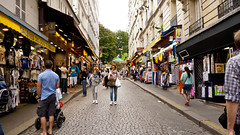Paris - The City
Paris, the capital of France, is one of world's largest and most populous cities of Europe. Located on the banks of River Seine, Paris with its two islands, Ile Saint Louis & Ile de la Citeis, and multiple hills is one of the most beautiful cities in the world. One of the most popular tourist destinations of Europe, Paris boasts of major contribution in all the fields of art and science, including education, fashion, and entertainment.

The Activity Log
The city when under Roman Empire was called Lutetia from 52 BC. During the reign of Julian the Apostate (360-363), it was christened as Paris, owing to its Parisii Gaulish inhabitants. This Gallo-Roman town prospered greatly in art and theatre, until the German invasion in 400 AD. In 508 AD, King Clovis I established it as the capital of France. The history of Paris also witnessed the rule of Scandinavian and British monarchy making it rich and versatile in all the forms of art under each ruler's influence.
Paris Musuem
The Art
Paris has been the center of creative achievements since centuries. The churches of Roman Empire (52 B.C.), Notre Dame & Sainte Chapelle Cathedral from 12th and 13th century are testimonials to the richness of Gothic Art of ancient times. During the 15th century, Paris became the hub of Mannerism and Allegories due to a heavy influx of Italian and Flemish artists into the city. Similar to tendencies in the North of Europe, art of early 17th century was a blend of Baroque and Roman Classicism. Louis XIV's efforts to glorify French creativity boosted the migration of painters from across the world to Paris. French Rococo and Neoclassicism of the 18th century continued French preeminence in art and science across Europe, bringing immense recognition to the Parisian folks. Although 19th and 20th century have witnessed myriad movements, including Symbolism, Naturalism, Impressionism, Expressionism, and Cubism, Paris continues to play a pivotal role in the art world.
The Icons
Paris is the birthplace and the refuge of some of the most famous painters of all times. Antoine Watteau (1684-1721), Francois Boucher (1703-1770), Gustave Moreau (1826-1898), Claude Monet (1840-1926), Pablo Picasso (1881-1973), Salvador Dali (1904-1989), Andre Derain (1880-1954), Fernand Leger (1881-1955), Juan Gris (1887-1927), and Max Ernst (1891-1976) are some such icons.
The Art Houses
The plethora of museums and monuments spread in this City of Light are a proof of its rich art heritage. Notre Dame Cathedral (1163) on Ile de le Cite is the oldest masterpiece of art and architecture in the city. The city's central landmark is world's largest museum, Louvre Museum, housed in Louvre Palace (1200). Its collection included artifacts from reign of Louis XIVI (1638-1715) to nineteenth century, including Leonardo da Vinci's (1452-1519) famous 'Mona Lisa' (1506). Its other attractions include Centre Georges Pompidou, Musee d'Orsay, Musee Picasso, Musee Rodin, and Musee du Montparnesse. The latest museum in Paris is Musee du quai Branly housing art from America, Asia, and Africa.
Conclusion
Paris, with its rich and diverse art heritage, has an iconic status in the art world. The beauty and grandeur of the city continues to fascinate people across the world, making it an abode of creativity in entirety.
David Wood's British-themed OO/HO scale layout of a place known as 'West Porton' featuring working trains, trams and trolleybuses ('electric trolleybuses' in American English). Filmed at the 2009 Festival of Model Tramways, which was at the Kew Bridge Steam Museum, London. Although it was not intended to as such the film includes a discussion between two visitors (me plus someone else)and Mr Wood about the layout and some of its features. At the end there are a few still images too. Powered via the overhead wires and using working trolleypoles the trolleybuses are model buses fitted with model tram electric motors. Most of them use the Faller system for steering although we also see some buses which use the now discontinued Brawa system. As is seen in the video, there is even a junction where different buses follow different routes! Getting it all to work - and without any dewirements - is an act of sheer genius- its simply fantastic. The metro train is based upon the iconic Paris metro Sprague trains, and painted 1st class red. A still image showing the Parisian trains overlays the screen at the appropriate moment. This image is copyright-free and was sourced from the Wikipedia Commons.
Keywords:
No comments:
Post a Comment